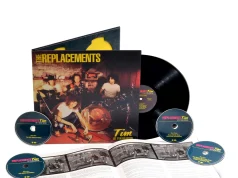
Plenty of musicians say the live show is where their music really comes alive and songs can take on a new life, evolving into something different — and often better — than the versions fans are accustomed to hearing on a record.
Dan Deacon certainly is one artist who uses his concerts as an opportunity to explore his music. That much is obvious in the set lists he’s using from night to night as he tours behind his recently released CD, America.
“We try to do the bulk of the set as the new record,” Deacon says. “But we always like to keep one-third of the set old material, like from the previous records, and then keep one third of the set unreleased material that isn’t on any record, sort of experiment there and try out new ideas.”
That doesn’t mean fans will hear Deacon’s music as it sounds on his albums.
America, for instance, offers an adventurous and wide-ranging blend of electronic instrumentation and live percussion mixed in with traditional instruments.
The album’s compositions cover lots of ground. There’s the instrumental “Guilford Avenue Bridge,” an aggressive soundscape complete with big, dance-friendly beats. There’s “Pretty Boy,” an instrumental that pursues a more lush, melodic and relaxed sound. “Crash Jam” (which features rather abstract choir-like singing) has a strong element of pop melody built into its hard-hitting trance-like groove. The four-part suite that closes the album, “USA,” has moments that hint at classical music, buzzing electronic dance music and an intoxicating mix of tribal rhythms that melt into robotic synthpop — all woven into a composition that’s as expansive and ever-shifting as the American landscape that helped inspire the album.
Considering Deacon has been touring in a much more minimal format — with his producer, Chester Endersby Gwazda, joining him on electronics and two drummers — there isn’t enough instrumentation to re-create the studio versions of the songs. But that wasn’t his goal in the first place.
The pair of drummers especially make the current shows quite different than earlier live performances.
“The drummers are Kevin O’Meara and Jeremy Hyman, two drummers that I trust very much,” Deacon says. “I love their playing style, and they’ve learned the parts in and out and now can internalize them as their own and add their own flourishes. … It adds a newness every night, whereas before, when I was playing to tracks, it was the same every single night.”
The one thing that Deacon hasn’t changed is the participatory dimension of his shows, as he strives to create an interactive vibe where fans — sometimes by the hundreds or more — join together in doing coordinated movements and dances, eliminating the traditional barrier between the artist and the concert audience.
The audience, Deacon says, is as essential to his show as the music itself.
“They’re another element of composition,” he says, noting that he has developed a trigger for the audience involvement. “If you’ve got this huge group of people to try to make situations that couldn’t arise organically, you need some sort of impetus to just start. And then [it’s about] putting that back into the audience and having them take it over from there and see how it goes and how it translates and transforms.”
The desire to evolve is something that has characterized Deacon’s work in the studio as well.
Now based in Baltimore, Deacon showed his interest in unconventional styles in his early records. Meetle Mice and Silly Hat vs Eagle Hat — both released in 2003 — were largely made up of instrumental sound collages. He followed those albums with a series of records made up of sine wave compositions.
But it wasn’t until 2007 that Deacon began to gain notice in indie music circles. That’s when he released his first widely distributed album, Spiderman of the Rings. It was followed by Bromst in 2009, a critically acclaimed CD that solidified Deacon’s status as one of indie rock’s most adventurous and creative new artists.
While America — the follow-up to Bromst — shares some common traits with Deacon’s earlier work, it takes Deacon into new territory as well, particularly with the “USA” suite. For the third part of that composition, “Rail,” Deacon employed upwards of a dozen musicians to create the orchestral elements.
The move toward using more guest musicians and traditional instruments is an avenue Deacon says he’d like to explore further.
“It’s a huge difference,” he explains. “I’m looking forward to not just working exclusively on the computer for the next record. I think it’s going to be really nice.”
Deacon says he can definitely hear a progression in his music, as well as elements that tie his most recent albums together.
“I think if you hear all three records linearly, Spiderman of the Rings, Bromst and into America, you can hear where the ideas grew and evolved from,” he said. “But I do think they all have their own, like you said, character and quality to their sound. There are different levels of density in their approaches, especially when it comes to the percussion and the vocals.”
Respond: [email protected]














